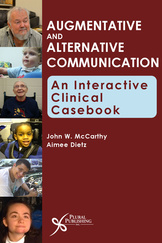Category: Graduate School
AAC: An Interactive Clinical Casebook
Thanks to Plural Publishing for helping me and Aimee Dietz produce AAC: An Interactive Clinical Casebook for speech-language pathology students and professionals.
Aimee and I set the stage for the resource by considering what it takes to move from being a beginning to an expert clinician.
This was a project 4 years in the making. We are so grateful to the incredible contributing authors for their work and to the people and families willing to share their stories so that students and professionals can learn and grow as a result.
Choosing a minor to go with CSD #slp2b
My advisees frequently ask me, “What should I minor in?” or “I heard having a minor is a good thing, which minor should I choose?”
I can think of many good reasons to add a minor. Maybe you took a course in an area and decided you would like to learn more. As you take more classes you find that it is of interest to you. If it arises out of your interest, I’ve never known someone to be disappointed. Minors can also be the logical result of a double major that just isn’t feasible for your own personal situation. Ultimately with a double major you frequently need to choose a primary direction anyway, so choosing a major/minor split might be a good way to start figuring it out. In other cases individuals choose minors to complement their major. I think this is fine, but I still think there has to be some kind of personal motivation there. There still needs to be interest, and I would even argue some passion for the topic. A minor still requires a prescribed program of study so following through with all the requirements still takes a commitment on the students’ part. Imagine majoring in something you weren’t particularly interested in. It would be much more difficult to complete. Majors that complement CSD logically can include things like linguistics, communication studies, and psychology, but they could also include physics, nutrition, or another health related field that could add depth or breadth to a CSD major. Just be sure these areas are truly of interest. Because…
There is a reason NOT to minor.
If you are minoring in something not out of your own interest, but out of a desire to distinguish yourself for graduate admissions, this is not a reason to minor in something. As someone who has been on graduate admissions committees and as someone who is now a program director, I look for students who passionately pursue their own interests. Pursuing something just to distinguish yourself to me is more like the student telling me what they think I want to hear. Students who are always looking for “the right answer” may struggle with clinical situations where there isn’t necessarily one single right answer. Whether I agree or not, I want to know what students are interested in. My experience when students minor in something that they aren’t passionate about is that they generally don’t do as well as when they take classes in areas they really like. Consequently they lower their GPA and their distinctiveness rather than increasing it. They then experienced frustration with both the content and their grades. This is a lose-lose situation.
As someone who majored in voice performance, I can tell you that your interests and your passion (as well as your demonstrated ability to perform in CSD classes) is what distinguishes you. Minors are an opportunity to pursue something of high interest to you. Ultimately getting the minor doesn’t even need to be your end goal if you have taken courses of interest. I was three credits short of minoring in Italian. It never held me back that I didn’t complete it (to my knowledge) and I never regretted not finishing the minor because I took courses of high interest, pursued study abroad experiences, but then ultimately decided to study some other languages as well.
I am not saying, don’t minor. I am saying let your minor grow out of your interests whether it is passion for a topic or a desire to broaden your perspective on a topic within CSD (but that is still interest related). Please, please, please, don’t minor in something because you think I want you to. I want to know what you want.
The Ultimate Flip: Intervention First in Teaching SLPs
There has been a lot of discussion of the “flipped classroom.” It generally refers to classroom time being focused on hands on activities while lectures and reading assignments are completed outside the classroom. There is another flip to consider in SLP. The flip of assessment and intervention coverage in the classroom. #slpeeps #slp2b
Assessment drives intervention. I know this. I believe this. It is a critical foundation for AAC practice. You have to understand a person’s needs and skills so that you can appropriately match the technology to those needs and skills. Does your teaching sequence have to match that though? What I intend to explore is the idea that it doesn’t.
Let me lay out several reasons why I’m considering this change:
1. Students don’t get enough time on intervention. There is so much to say about assessment. Good assessments are critical. But if you spend too much time talking about assessment, you may run out of time in the semester to talk about intervention.
I keep hearing from students that they know a lot of how to assess, but don’t feel at all confident when it comes to intervention. This poses a serious problem for them.
2. Expert AAC clinicians are not linear thinkers.
3. Students needs to not be linear thinkers and they are already set up for way too much of it.
4. Students are already doing clinical work in intervention. Frequently they are on either a diagnostic rotation or an intervention one, but there frequently isn’t continuity there for many reasons.
5. Students who transition to work in the school system inherit a caseload. Going back and doing assessment with everyone there would require reengagement of the IEP process, which takes an extended period of time and STILL requires that intervention be done in the meantime.
So how will I accomplish this? I plan to present a case per week where there are intervention goals and activities already illustrated. Students have access to the assessment information as well, but the focus will be on the goals, research related to the intervention technique(s) and programming/ideas for how to implement a goal in a given clinical session or in a given setting. At least one App (probably more) will be discussed with each case. At the end of the course after the students have had some experience seeing intervention, we will discuss assessment. We’ll look at tests/checklists/profiles/informal methods with regard to the cases we have already discussed. They will still be getting all the information.
I am writing this so that I commit to doing this. I have frequently promised to do more related to intervention in my class. Now I am publicly committing to it. Look for future blog posts to see how it turns out or feel free to comment 🙂
For #slp2b: Faculty perspective on Grad School Application Process
This post originated in a reply to a entry on Katie Millican’s truly excellent blog. http://slpecho.wordpress.com/
I thought I would also post it here, but I give credit to Katie for inspiring this. The original post was a set of good questions about why the Graduate School Application Process can’t be more streamlined.
Original post:
I can greatly appreciate the added stress that tracking multiple requirements creates in this [the graduate school application] process. As Elizabeth noted, CSDCAS is an effort to help reduce this stress [the fact that every school has different requirements for what to fill out, where and how] nationwide. Individual programs elect to participate and a list of participating institutions can be found by checking the CSDCAS website.
It is my firm belief that programs are not deliberately trying to make the process difficult. One of the challenges has to do with what individual universities will allow. CSDCAS definitely helps but there can still be differences program to program even with CSDCAS. A discussion of this delves a little into the depths of university-organized structures so I’ll try to be brief. A university generally has different colleges within it. The colleges then have schools/departments/units. That means you could have a University with a College of Health Professions (generic choice of name) and then a Department of CSD. You might also have a university that tracks graduate students separately through what is known as a Graduate College in addition to the structures above. OK. So why is this important? It is important because different entities within the university have negotiated their own ways of tracking students for administrative and financial purposes (graduate assistantships for example). Each of them works to a certain extent autonomously, but must still relate to the others in some way now and then. So the way that CSD tracks students may differ slightly from the way that programs own College of Health Professions does as well as the way that University’s Graduate College does. Once different facets of the organization are involved each has their own particular way of doing things. So in addition to a CSD unit’s decision to join CSDCAS, the program may still need to have students be tracked through a different university pathway such as a Graduate College. It is the negotiation of these structures within each university that make things tricky. I do this as part of my job and still say Huh?
What this means for students is that they may or may not need to file multiple forms with the same university or the forms they file for each university may look different. This isn’t meant to defend the practice necessarily, but at least to provide a little perspective. Universities have thousands, sometimes tens of thousands of graduate students all of whom need to be tracked by a number of different units across a university. In the same way that having a centralized application process for CSD applicants would be helpful, a single platform for universities to communicate internally would also be good. Unfortunately there are a number of barriers to go into related to that…









